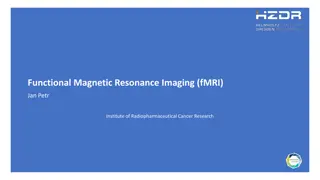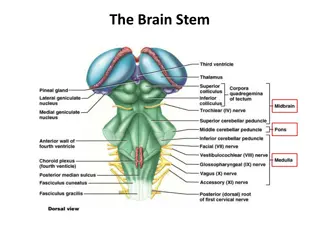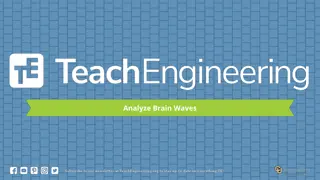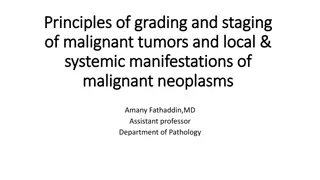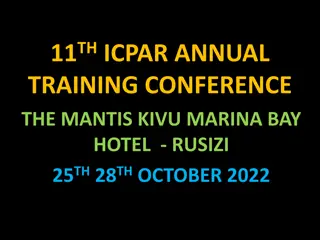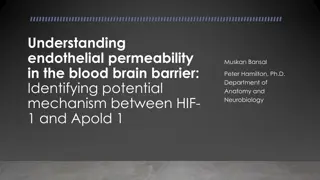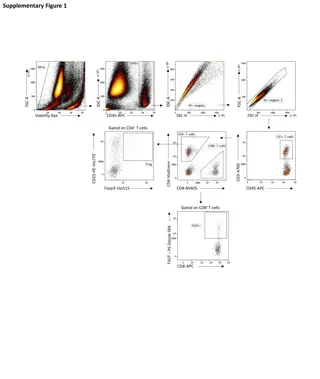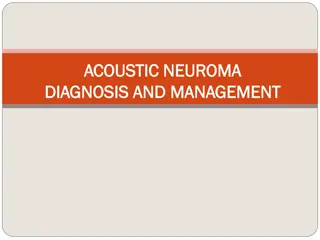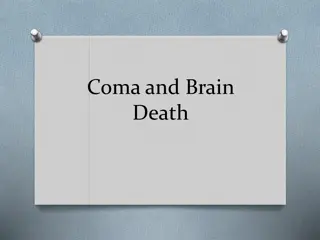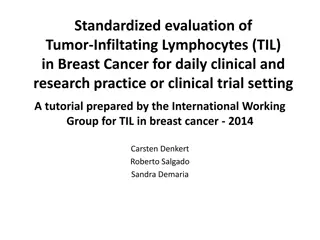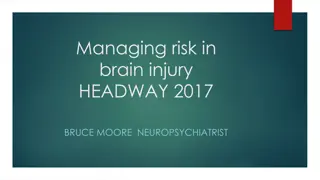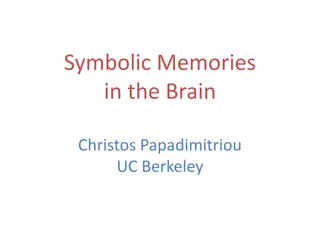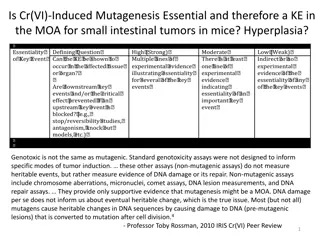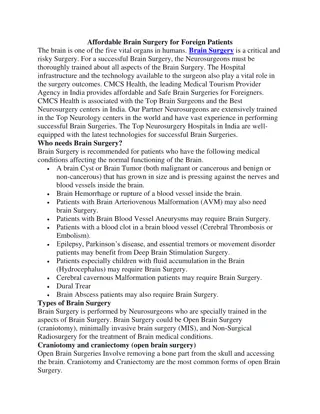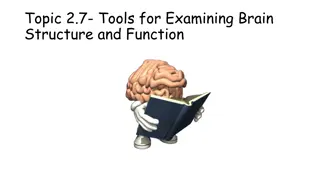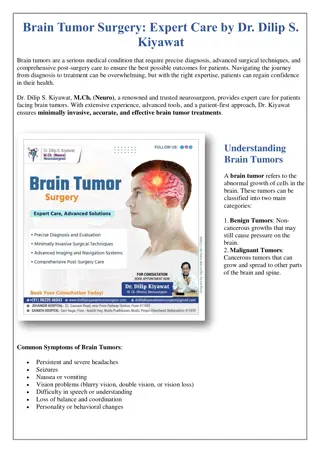Improving HER2 Targeting in NSCLC With Selective TKI
HER2 activation plays a crucial role in promoting tumor proliferation and survival in NSCLC. Driven by oncogenic downstream signaling pathways, HER2 overexpression and gene amplification lead to the formation of heterodimers and activation of key signaling cascades. Additionally, HER2 mutations are
0 views • 36 slides
Understanding Tumor Classification and Nomenclature in Pathology
This slideshow provides an overview of tumor classification, nomenclature, and key concepts in pathology. It covers the definitions of neoplasm, tumor, and oncology, the classification of tumors into benign and malignant categories, as well as the importance of stroma in tumor behavior. It also expl
4 views • 61 slides
Comprehensive Overview of Brain Imaging Techniques and Anatomy
Explore the world of brain imaging with functional MRI, MRI techniques, brain anatomy, neuronal activation, and brain vasculature explained in detail, shedding light on brain regions and their functions.
10 views • 53 slides
Understanding the Brain Stem and its Functions
Explore the intricate structures of the brain stem, including the midbrain, pons, and medulla oblongata. Learn about the functions of the cerebellum, its role in controlling postural reflexes and producing skilled movements. Discover the thick tracts connecting the cerebellum to the brain stem and t
8 views • 20 slides
Understanding the Brain: Stem, Midbrain, Pons, Medulla, and Cerebellum Functions
Explore the complex structures and functions of the brain, including the brain stem, midbrain, pons, medulla, and cerebellum. Discover how these regions play crucial roles in controlling reflexes, movements, and vital functions like respiration and posture. Learn about the thick tracts connecting th
7 views • 21 slides
Comprehensive Spine Tumor Surgery at Medspine Hospital in Chennai
Discover the best spine tumor treatment at Medspine, the leading hospital with top surgeon and specialist in Medavakkam, Perumbakkam, Royapettah, Chennai.
3 views • 2 slides
The Truth Revealed Does Cannabis Harm Brain Cells.docx
The Truth Revealed: Does Cannabis Harm Brain Cells?\nIn recent years, the debate surrounding the effects of cannabis on brain health has intensified. With the growing popularity of cannabis and the increasing accessibility of products from online weed dispensaries and marijuana dispensaries, it\u201
9 views • 3 slides
Brain Injury Services: Empowering Recovery and Support
At Brain Injury Services, we are committed to making a positive difference in the lives of individuals affected by brain injury. Through our comprehensive support services, compassionate care, and commitment to empowerment, we empower survivors to overcome obstacles, reclaim their independence, and
7 views • 7 slides
Exploring Brain Waves Through EEG Analysis
Delve into the world of brain waves with EEG, EKG, and EMG measurements. Learn how to analyze brain wave data using mathematical processes like Fast Fourier Transform (FFT) and Power Spectral Density (PSD). Discover the significance of different frequencies in brain wave signals and how they reflect
1 views • 13 slides
Best Neurosurgery Hospitals in India
Neuro diseases are very bad diseases. Many people are caught by Neuro diseases nowadays. It is related to brain diseases. Many people in India are caught by Neuro Diseases. It happens in Adults as well as children.\nA person of any age can be affected by this. Before this time very bad disease Named
1 views • 2 slides
neurosurgeon in jaipur-Dr Himanshu Gupta
brain tumor is an abnormal growth of cells in the brain. Tumors can be either cancerous (malignant) or non-cancerous (benign). Cancerous tumors grow and spread aggressively, potentially invading nearby tissues and spreading to other parts of the body, while non-cancerous tumors are usually less aggr
0 views • 5 slides
Understanding Intimate Partner Violence and Brain Injury Connections
The link between intimate partner violence (IPV) and brain injury is significant, with studies showing a high prevalence of brain injuries among IPV survivors, particularly women. Common types of IPV causing brain injury include hits to the head, strangulation, and banging the head against objects.
1 views • 23 slides
Understanding Grading and Staging of Malignant Tumors in Cancer Patients
Grading and staging are crucial in determining the aggressiveness and extent of malignant tumors. Grading involves assessing the level of malignancy based on cell differentiation and mitotic activity, while staging considers the size of the tumor, lymph node involvement, and presence of metastases.
7 views • 31 slides
Unlocking the Power of the Human Brain: Insights from 11th ICPAR Annual Training Conference
Delve into the intricacies of the human brain at the upcoming 11th ICPAR Annual Training Conference themed around "Brain Power to Embrace Change and Emotional Stability." Explore the control center of our minds, the cerebral cortex, the limbic system, and the role of neurons in conscious mental reac
0 views • 57 slides
Molecularly-Guided Therapy vs Platinum Chemotherapy in CUP Patients
This trial aims to compare the efficacy and safety of molecularly-guided therapy or cancer immunotherapy based on genomic profiling with platinum-based chemotherapy in patients with cancer of unknown primary site. The study design includes multiple treatment regimens guided by genomic profiles, with
4 views • 9 slides
Understanding Wilms Tumor in WAGR Syndrome
WAGR syndrome is a rare genetic condition associated with Wilms Tumor, aniridia, and developmental delays. Wilms Tumor is a form of kidney cancer mostly affecting children and is linked to genetic disorders like WAGR syndrome. The risk of Wilms Tumor is higher in children with WAGR syndrome, with po
1 views • 14 slides
Maintaining Brain Health and Cognitive Function: Key Factors and Risks
Aging well and maintaining brain health require a combination of genetic, environmental, and lifestyle factors. While age-related changes in memory and learning may occur, adopting a healthy lifestyle, avoiding risks like smoking and excessive alcohol use, and being aware of how medicines can impact
0 views • 23 slides
Positron Emission Tomography: Applications in Society and Recent Developments
Positron Emission Tomography (PET) is a medical imaging technique focusing on metabolic differences in the body. By using positron-emitting radioisotopes, PET can detect how molecules are taken up by healthy and cancerous cells, aiding in accurate tumor localization with lower doses. The evolution o
0 views • 6 slides
Combined Effect of Charged Particles Irradiation and Anticancer Drugs in Cultured Human Tumor Cells
Research collaboration aimed to enhance locoregional tumor control and reduce distant failure by combining charged particles irradiation and anticancer drug Epothilone B in cultured human tumor cells from Milano and Roma. The study explores the impact on clonogenic survival, growth curves, and deter
0 views • 13 slides
Exploring the Brain and Conflict Resolution in Recovery
Delve into the complexities of the brain with a focus on the limbic system and cortex. Learn how the brain reacts in conflict situations and discover strategies for conflict resolution in recovery. Gain insights into the functions of the limbic system, located at the center of the brain, and the cor
0 views • 25 slides
Understanding Gamma Knife Stereotactic Radiosurgery
The Gamma Knife Stereotactic Radiosurgery is a precise and effective treatment method where highly focused radiation beams are used to target tumors and abnormalities in the brain. It does not remove the tumor directly but affects DNA, cell growth, and blood vessels. The procedure involves three mai
0 views • 51 slides
NCI-MATCH Trial Interim Analysis Results and Status Update
NCI-MATCH is a groundbreaking clinical trial aiming to match tumor gene alterations with targeted therapies. The interim analysis results revealed impressive patient enrollment and site participation exceeding expectations. Despite challenges with pausing new patient registrations for the analysis,
0 views • 26 slides
Investigating HIF-1 and Apold-1 in Endothelial Permeability at the Blood-Brain Barrier
Understanding endothelial permeability at the blood-brain barrier is crucial for drug delivery to the brain. This research aims to identify a potential mechanism between HIF-1 and Apold-1 specific to cerebral epithelial cells that may impact the integrity of the blood-brain barrier. The study involv
0 views • 14 slides
The Intersection of Opioids and Brain Injury: Addressing Addiction Through a Brain Injury Informed Lens
Exploring the correlation between traumatic brain injury (TBI) and the opioid crisis, this content delves into the alarming statistics of opioid overdoses and their impact on individuals with brain injuries. Highlighting the overlap and consequences of these two major health issues, it sheds light o
0 views • 45 slides
Understanding the Right Brain vs. Left Brain Theory
Explore the intriguing concept of right-brain vs. left-brain dominance theory, where each side of the brain is associated with different thinking styles. Delve into the history, key characteristics, and tasks attributed to the right and left hemispheres, and learn more about the work of Roger Sperry
0 views • 8 slides
The Intriguing Connection Between Emotions and the Brain
Exploring the complex relationship between emotions and the brain reveals that while our heart often takes the spotlight for feelings, it is actually the brain that plays a crucial role in regulating emotions. The limbic system, composed of various brain structures, controls emotional responses, suc
0 views • 10 slides
Detection of Mutations in EGFR in Circulating Lung Cancer Cells: Study on SARMS Assay and CTC-Chip
This study by Shyamala Maherswaran, Ph.D., and team focuses on characterizing mutations in EGFR in circulating tumor cells using SARMS assay and CTC-chip. The research investigates the effectiveness of these non-invasive methods in analyzing tumors and explores the role of the T790M mutation in resp
0 views • 12 slides
Immune Cell Analysis Supplementary Figures
This collection of supplementary figures provides detailed flow cytometry data on immune cell populations, including CD4+ T cells, CD8+ T cells, tumor-associated macrophages, and more. The figures also include information on immune checkpoint molecules like PD-L1 and TIGIT. Each figure presents spec
0 views • 4 slides
Understanding Acoustic Neuroma: Diagnosis and Management
Vestibular schwannoma, also known as acoustic neuroma, is a common tumor in the cerebellopontine angle. It can be sporadic or associated with neurofibromatosis type 2. Patients typically present with hearing loss and tinnitus, which may be gradual or sudden. Grading systems like Koos, Ojemann, and J
0 views • 75 slides
Understanding Coma, Brain Death, and the Examination Process
Exploring the definitions of coma and altered consciousness, understanding brain death examinations, criteria for determining brain death, who can perform the exam, Texas law on the definition of death, and components of a brain death exam. Learn about different states of altered consciousness, the
0 views • 14 slides
Epidemiology and Pathology of Brain Tumors - Overview and Incidence Statistics
This information provides an in-depth overview of the epidemiology, classification, and pathology of brain tumors. It covers the relative incidence of various brain tumors, including astrocytoma, glioblastoma, meningioma, and others. The data also includes statistics on the occurrence of brain tumor
0 views • 98 slides
Tutorial on Standardized Evaluation of Tumor-Infiltrating Lymphocytes in Breast Cancer
This tutorial, prepared by the International Working Group for TIL in breast cancer, provides guidelines for pathologists on the standardized evaluation of tumor-infiltrating lymphocytes (TILs) in breast cancer based on H&E slides of core biopsies or tumor resections. It details steps such as defini
0 views • 14 slides
Activate Your Brain with Rhythm and Movement for Enhanced Learning
Engage both sides of the brain by incorporating rhythm and movement into education with STEAM activities. Enhance memory retention, reading readiness, and critical thinking skills through various exercises like brain dance, rhythm activators, and tiptoe feet. Discover the benefits of maintaining a s
0 views • 17 slides
Integrative Inference of Tumor Evolution from Single-Cell and Bulk Sequencing Data
Cancer's complex evolution introduces challenges in treatment response. B-SCITE aims to enhance tumor phylogeny inference by integrating bulk sequencing and single-cell data using a probabilistic approach. It addresses the complexity of tumor cell populations and potential treatment failure causes.
0 views • 20 slides
Managing Risk in Brain Injury: Strategies and Considerations
This informative content covers essential aspects of risk management in brain injury, including balancing client needs, promoting independence, and positive risk taking. It delves into the different parts of the brain, their functions, and the potential effects of brain injury on intellectual, behav
0 views • 14 slides
Exploring Computational Theories of Brain Function
In this series of images and text snippets, the discussion revolves around the emerging field of computational theories of brain function. Various aspects such as symbolic memories, the relationship between the brain and computation, the emergence of the mind from the brain, and computational thinki
0 views • 53 slides
Essentiality of Cr(VI)-Induced Mutagenesis in Small Intestinal Tumor Development in Mice
Cr(VI)-induced mutagenesis is a key event in the mode of action for small intestinal tumors in mice, with the question of whether it is an essential step in tumor development. The interaction of cellular components with Cr leads to cell proliferation, hyperplasia, and ultimately mutagenesis. Differe
0 views • 4 slides
Affordable Brain Surgery for Foreign Patients
The brain is one of the five vital organs in humans. Brain Surgery is a critical and risky Surgery. For a successful Brain Surgery, the Neurosurgeons must be thoroughly trained about all aspects of the Brain Surgery. The Hospital infrastructure and t
0 views • 2 slides
Exploring Brain Structure and Function: Tools and Insights
Discover how scientists study the brain through accidents like Phineas Gage's, lesions, and advanced techniques like EEG, CAT, MRI, PET, and fMRI. Learn about the divided brain, split-brain patients, and the role of the corpus callosum in communication between brain hemispheres.
0 views • 8 slides
Brain Tumor Surgery in pune Expert Care by Dr. Dilip S. Kiyawat
Dr. Dilip S. Kiyawat, an experienced M.Ch. (Neuro) Neurosurgeon, offers advanced brain tumor surgery with expert care. Services include precise diagnosis, minimally invasive techniques, advanced imaging, and post-surgery care. Book your consultation
0 views • 4 slides


